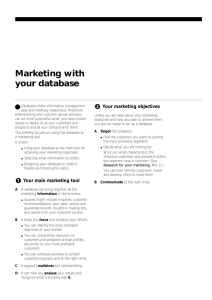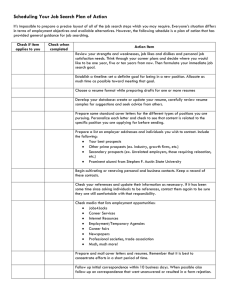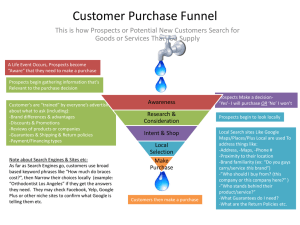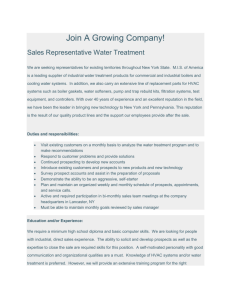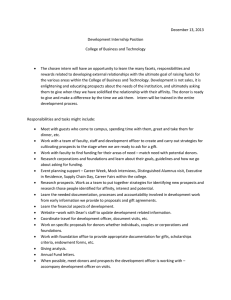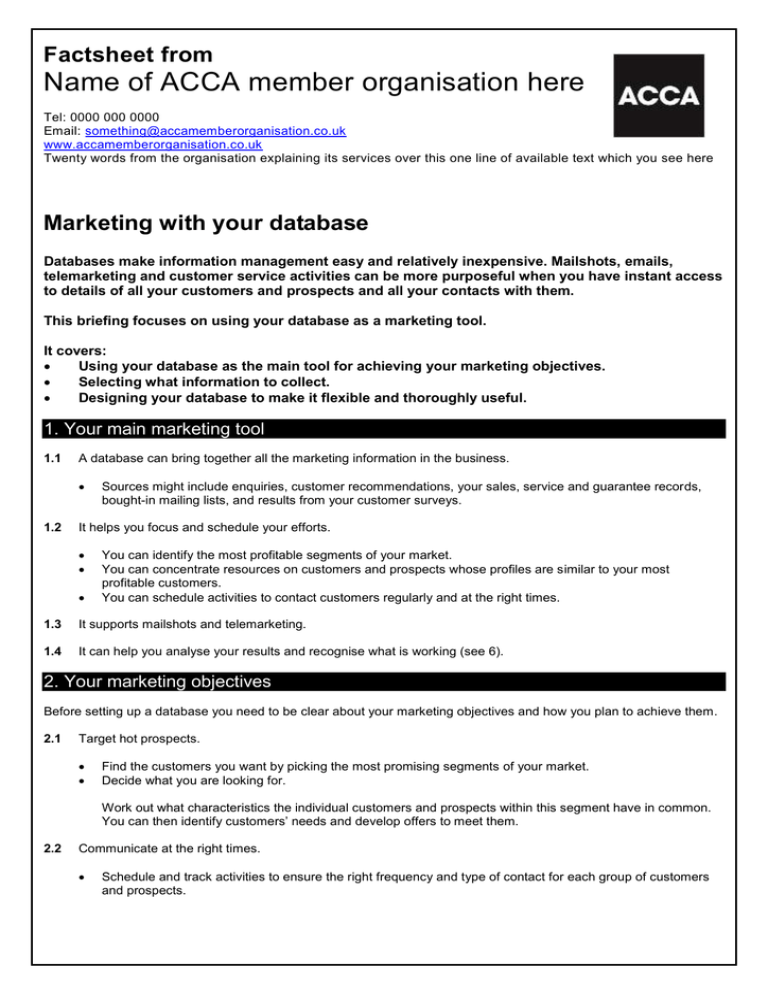
Factsheet from
Name of ACCA member organisation here
Tel: 0000 000 0000
Email: something@accamemberorganisation.co.uk
www.accamemberorganisation.co.uk
Twenty words from the organisation explaining its services over this one line of available text which you see here
Marketing with your database
Databases make information management easy and relatively inexpensive. Mailshots, emails,
telemarketing and customer service activities can be more purposeful when you have instant access
to details of all your customers and prospects and all your contacts with them.
This briefing focuses on using your database as a marketing tool.
It covers:
Using your database as the main tool for achieving your marketing objectives.
Selecting what information to collect.
Designing your database to make it flexible and thoroughly useful.
1. Your main marketing tool
1.1
A database can bring together all the marketing information in the business.
1.2
Sources might include enquiries, customer recommendations, your sales, service and guarantee records,
bought-in mailing lists, and results from your customer surveys.
It helps you focus and schedule your efforts.
You can identify the most profitable segments of your market.
You can concentrate resources on customers and prospects whose profiles are similar to your most
profitable customers.
You can schedule activities to contact customers regularly and at the right times.
1.3
It supports mailshots and telemarketing.
1.4
It can help you analyse your results and recognise what is working (see 6).
2. Your marketing objectives
Before setting up a database you need to be clear about your marketing objectives and how you plan to achieve them.
2.1
Target hot prospects.
Find the customers you want by picking the most promising segments of your market.
Decide what you are looking for.
Work out what characteristics the individual customers and prospects within this segment have in common.
You can then identify customers’ needs and develop offers to meet them.
2.2
Communicate at the right times.
Schedule and track activities to ensure the right frequency and type of contact for each group of customers
and prospects.
2.3
Monitor progress.
Generate reports to show conversion rates by market segment and by activity.
Identify unrecognised opportunities by comparing one group with another.
3. A system for marketing
Unless mail order is a major part of your future plans, you will not usually need to buy in a specialist marketing
database system.
3.1
Low cost and even free contact management systems are now available either off the shelf or using on demand
software licensing.
3.2
The latest contact management and email database tools will have been specifically designed to handle the
majority of your business’ marketing requirement.
You can choose to buy “cloud-based” software (based online) or software that you can load on to your own
internal network.
Ease of use is the key factor.
A database that is not easy to use and is unresponsive will not be used to the full.
It must be quick and easy to put in new data and to update existing records.
3.3
How you can use your database depends on the specification of your system.
3.4
If your team work from home or different locations regularly, remote access to the information will be vital.
Consider using cloud systems in this case.
Choose a flexible database that will support mailshots (including email), generate reports as needed, allow
you to modify selections from a list and connect with your word processing software.
As an analytical tool, your database must allow you to select and look at information in many different ways
(see 6).
Before buying, decide whether you need to import and export data to and from applications like your website,
order processing or automated credit card handling.
Other issues include total database size, scale and frequency of updates, likely user numbers and any
special requirements.
Consider the processes that are likely to be used to input and extract data.
Typing in information is straightforward for small volumes, but creates problems if there are thousands of
leads to capture.
Bringing in temporary help or outsourcing may be the only practical way to deal with inputting a large amount
of new data, especially if it is not in a standardised form.
It may be possible to scan in data that comes to you in printed form.
Batch processing of input data in electronic formats is an important part of specialised marketing databases.
Data imported in batches is automatically assigned to the right fields.
3.5
Forms on your website can be used to collect addresses, including email addresses. Be sure you also allow
people to take their names off your database and unsubscribe from your emails. Take care to follow Data
Protection regulations.
Cost is unlikely to be the major factor in your choice of database.
2
Initial software costs will be insignificant compared with the ongoing costs of data input, updating and
maintenance.
4. Designing the database
Forget the computers and work out what you need from your database. Once you know what you want the database to
do, invite database experts to advise on the best options for achieving your goals.
4.1
Accuracy comes naturally, if the system helps the user.
Give operators short-cut options to click on, so that they do not have to type everything out in full each time.
Leave room for multiple records.
Include fields for commentary notes in your database. Otherwise operators will jot comments down in other
empty fields, potentially causing serious problems.
In most PC-based or online contact management systems, this is all done for you.
4.2
Make the database as flexible as possible.
You need to be able to generate a pick list of data, then add and delete entries or groups of records to get
the exact list you wish to use for your mailshot (or report).
You must be able to run mailmerge operations, combining the database with your word processing or email
software, to send letters or emails to lists of people.
You should be able to run off one label for a single envelope, or 2,000 labels for a mailshot, without any
complications.
4.3
Each customer’s contact history needs to be readily accessible, to ensure you do not send the same
communication twice.
4.4
Use categories, codes and key data fields to organise the data as a whole (see 5).
●
●
These allow you to filter in, and filter out, the records you need for analysis or for targeting a marketing
campaign.
Make use of validated fields, where only one of a range of codes can be entered.
For example, your ‘gender’ field would accept ‘m’, ‘f’ or ‘na’ (information not available), but would bar any
other entry.
4.5
Use unambiguous descriptions for data.
●
4.6
Check that the meaning of a tick or a mark in a field is clearly defined. For example, you need to know
whether your ‘customer’ flag includes lapsed customers.
Use dates to generate time-sensitive data, such as a person’s age.
A good database requires you to capture as little data as possible to fulfil your objectives. Check at each stage that
what is being delivered meets your agreed specification and needs.
5. Categories and identifiers
By cleverly coding information, you can retrieve data on any selected group of contacts.
5.1
Break the data in each segment down into categories and sub-categories, and give each one a code.
The first level of categories might divide your contacts into customers, prospects, influencers and others.
Customers might then be sub-categorised according to size and frequency of orders.
Prospects might be sub-categorised more subjectively, as hot, warm, and cold, or as having large, medium
or small potential.
3
5.2
Use ‘identifier’ codes to flag specific facts that will help you in your marketing.
These can be unique to you and can carry precisely the information that matters to your business.
Unless it has been set up to do so, your system won’t turn ‘m’ into ‘male’ automatically. Keep a ‘data
dictionary’ that logs exactly what each code means.
6. Useful analysis
Track your outgoing communications and identify what is working.
6.1
See which segments of the market are the most promising.
6.2
Analyse the profile of your best customers and see what they have in common.
6.3
Generate reports by area, postcode, sales channel and advertising medium. Look for patterns connecting
your sales successes.
Once you know this, you can target prospects with similar characteristics.
You can group individual business contacts by job description and by whether they are decision makers,
influencers or end users.
Monitor which campaigns are working, by tracking where leads and sales come from.
Leads may come indirectly, via key influencers who recommend but do not purchase. For example,
accountants may recommend accounting software.
For these influencers, you want space in the database for details of their interests and the date they were
last thanked.
6.4
If you use your database as a sales database, monitor which sales people are winning new customers — or
losing accounts.
6.6
Use the database to collate the results of customer research you carry out.
7. Keep a clean database
Investing effort to improve the quality of your data is essential if your marketing campaigns and analysis are to be
effective.
7.1
Removing duplicates is vital, whether it is done automatically or by manual checking.
7.2
Update your data often. An unmaintained list is generally unusable after two years.
7.3
Customers are irritated by duplicate mailshots — and you waste money.
Contacts whose mail comes back undelivered should be removed from your database saving you money
next time.
Set clear rules about when and how information is updated and who does it.
Have a ‘last updated’ field to monitor data age.
Get feedback. Encourage recipients to correct errors in their name and address details or to say no to any
further contact.
Devise systems to check data for errors.
●
●
●
Spot checking by eye is surprisingly effective.
Use software that automatically generates an address from a postcode and checks the spelling against
Royal Mail’s files, (details from Royal Mail, 08457 740 740).
Give each customer a URN (unique reference number), which goes on the letter and the envelope. It
ensures every update is matched to the right record.
4
●
7.4
Every database can use URNs. Sort orders by URNs, rather than names, and you can be sure that
nothing has been duplicated.
Give employees credit, and make them accountable, for the data they have entered.
●
Consider tagging information, so you can see who entered how many records each month and reward good
performance.
8. Data security and privacy
8.1
You will need a routine of regular data back-ups to keep your records safe.
Always keep at least one current copy of your database away from your site and make a daily back-up.
8.2
You must register with the Information Commissioner's Office if you hold personal details of customers or
prospects (01625 545 745 or www.ico.gov.uk).
8.3
In general, you must obtain the prior consent of your recipient before using their email address for marketing
purposes (and always provide an option to opt-out).
The data you need
You do not need to know everything about your business-to-business customers to market your goods or services to
them.
Decide what information is likely to justify the costs of collection and updating before setting up your database. Do not
collect what you are not going to use. You might need fields for:
●
Company name, address and postcode.
●
●
●
●
●
●
●
●
●
●
●
●
Industry type (SIC code).
Number of employees at this site (ask).
Name, title and function.
Interested in receiving relevant mailings, fax or email.
Influencer, specifier or purchaser.
Phone, mobile, fax and email details.
Ever responded/bought before.
Buying history — what, when, where, why.
Size and date of last purchase.
Credit history.
Source of data.
Your account manager/sales channel.
Marketing to consumers
Marketing to consumers usually means talking to large numbers of prospects, with little opportunity to find out about
them.
A.
In consumer marketing, the information on your database may be all the information you can ever get about a
customer. Targeting and offers will revolve around identifying prospects who are like your existing customers. As
a minimum, try to collect:
Name and initials.
Address (with postcode), phone and email details.
Gender, date of birth.
Buyer, responder or competition entrant?
Price paid and payment method.
Source of name (a recommender may be the key to better marketing).
5
B.
Some data means more than it seems to.
Paying by charge card, rather than credit card, may indicate a high-income home.
Prospects who give several initials are typically older and wealthier, as are those whose houses have
names.
Expert contributors
Thanks to Professor Malcolm McDonald (Cranfield School of Management, 01234 751122); Gillian Angel (Clarity in
Marketing, 020 7520 9404); Lucy Whittington (Inspired Business Marketing, 07789 997756).
Further Help
Last updated 01.06.11
© BHP Information Solutions 2011. ISSN 1369-1996. All rights reserved. No part of this publication may be reproduced or transmitted without the
written permission of the publisher. This publication is for general guidance only. The publisher, expert contributors and distributor disclaim all liability
for any errors or omissions. Consult your local business support organisation or your professional adviser for help and advice.
6

